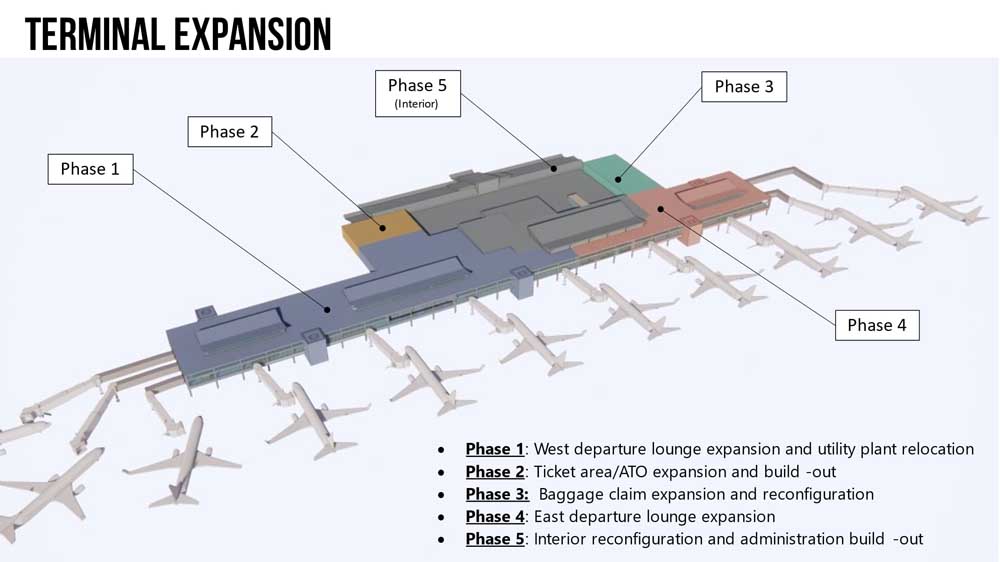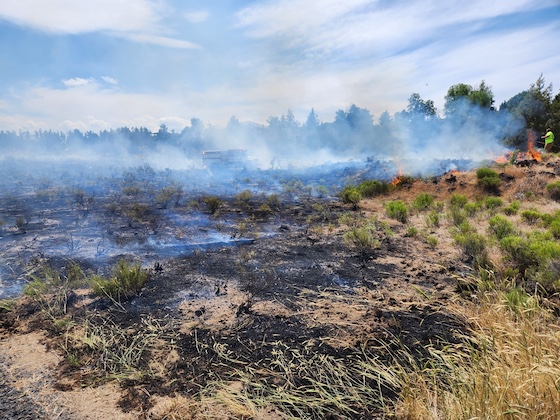Redmond Airport expansion ready to take flight
Published 5:00 am Tuesday, August 16, 2022

- Concept art of a possible design for the expanded Redmond Airport.
Passengers at the Redmond Airport often catch a glimpse of the snow-capped Cascades that surround it, as well as a facility filled to capacity.
As the region swells with new residents, businesses and tourists, the only major commercial airport in Central Oregon finds itself, again, at a critical stage of development.
The current terminal was heavily expanded in 2009, when the airport saw about 460,000 passengers file through its gates. A dozen years later, that number had more than doubled. In 2021, more than a million passengers flew in and out of Redmond Airport, which has led to congestion in everything from security lines to waiting areas.
A master plan written in 2016 projected that the airport wouldn’t hit a million annual passengers until 2026.
“We just at some point can’t put more people in a building,” said Zachary Bass, director of the Redmond Airport. “We need a bigger terminal.”
Bass has a plan — and significant financial assets — to build a bigger, better terminal. Plans are already underway for a massive expansion of Redmond Airport that could top out at a cost of $200 million.
The need
Since twice as many people are flying through the city-owned airport than did a decade ago, Bass said there’s not enough space for baggage claim, queue lines are cramped and there’s often not enough seating at gates, in food areas and outside security. And much of the space they have is poorly designed. Not many travelers take advantage of the views and food options on the second floor of the airport, because travelers can’t see or hear updates from their gate.
“We have limited hold room,” Bass said. “Not a great option of retail and concessions and food. Bathrooms are getting too small and so we know we need more space to accommodate this growth.”
Though the COVID-19 pandemic decreased air travel temporarily, the number of travelers using the Redmond Airport has already bounded back, with no signs of waning.
“The overall story is we’ve done better than we expected with COVID and we came back quicker than most of the country,” Bass said.
He expects to the number of travelers to continue ticking up and believes now is the time to plan that continued growth.
The plan
The first phase of the airport expansion will add more retail options, as well as additional places to get food and drink on both sides of security. Bass said they have designed an expanded “hold area” past security that will have more space for passengers for queuing in ticket lines or waiting to board. They also plan a complete redesign of the second floor, which would reduce the number of flights that passengers would board outdoors on the tarmac. Plans call for six or seven jet bridges that would make for more efficient loadings and unloadings, especially in winter.
The cost of the first phase of the expansion will be in $90-100 million range, which Bass said the airport can pay for with saved funds and federal grants.
Additional phases of the expansion are subject to change, and dependent on how much money the airport is able to acquire.
According to the November 2021 concept plan, the second phase of expansion would enlarge and redesign the ticket area and air control tower. Phase three would expand and reconfigure the baggage claim area and the next phase would revamp and expand the east side departure lounge. A final phase would focus on an interior reconfiguration and relocate airport administration offices.
If the airport is able to get all five phases finished, Bass said there could be roughly 12 additional gates at the airport, which he said would likely be attractive for airlines to add additional connections to RDM.
Bass emphasized that, despite hundreds of millions in upgrades, airport administrators want it to keep the same feel that it has now.
“We’re still going to be a smaller airport,” he said. “We still want to have that feel of this lodge feel … this Central Oregon feel.”
Impact on economy
An expanded airport would be an asset for increased business investment and opportunities for the region, according to Jon Stark, CEO of Economic Development for Central Oregon. He said the more Central Oregon is integrated into the wider transportation network, the more it makes sense to build and expand in the area.
“The airport is a major component to the success of the economic development in the region,” Stark said. “Without it, we’re an island.”
With Central Oregon one of the fastest growing regions in the country, he said, the airport expansion is timely and will help attract more flights. Destinations such as Chicago and Dallas/Ft. Worth are on the radar, he said.
Additionally, an expanded airport can bring in more tourists, and offer Central Oregon residents a wider variety of direct destinations.
“As the marketing arm for the region, Visit Central Oregon is really excited for the expansion and the flights it will support,” said Katie Johnson, the communications manager for the Central Oregon Visitors Association. “We’ve got a lot to offer here year round.”
The impact from the expansion will be felt across Central Oregon. According to the State of Oregon’s economic impact report, the full expansion is expected to add 207 jobs and bring in $39 million a year to the area. Those numbers will be even higher during the five-year construction window.
“The airport, in some ways, is as important as the Deschutes River or the Cascade Mountains when it comes to determining the success of Central Oregon,” said Redmond City Manager Keith Witcosky. “It’s essential that we make sure that this airport is as successful as it can be and can accommodate the demand that we’re seeing.”
The money
Construction is expected to begin on the $100-million first phase in late summer or fall of 2023. It is expected to take two years to finish. Most of that cash is already in hand, including $25 million in savings from fees paid by travelers and 75 percent likely to come from state and federal grants.
Bass noted that the expansion will not be funded by a local general obligation bond or city taxes.
Bass explained that the airport, while owned by the city of Redmond, has a unique setup and acts virtually like its own municipality. It has its own fire department, employs its own security service, and has its own administration, and oversees dozens of lease agreements with businesses and organizations who operate on its land.
Money from the city doesn’t flow into airport coffers, nor does money collected at the airport go back into the city.
There is plenty of federal money heading to the nation’s transportation system.
The 2022 Bipartisan Infrastructure Law set aside $15 billion for airport infrastructure and its smaller terminals program sets aside $1 billion over five years.
“We plan on competing hard over the next four to five years,” Bass said.
A Connect Oregon grant could also be another funding opportunity, Bass said. The program was created in 2005 to finance “non-highway modes of transportation” and has awarded $463 million to 221 projects since its inception.
“We’re trying our hardest to get every dollar possible to put into this terminal, including our own money,” he said.
Additionally, the airport may take out a revenue bond. Separate from a general obligation bond with taxpayers footing the bill, the revenue bond would instead be issued against the airport’s revenue and ability to repay the debt service.
“This project most likely will end up with 25 to 30 separate grants supporting it on top of our cash and the revenue bond,” said Bass.
Moving forward
Bass said he hears a lot from travelers who want to see additional flights and amenities at the airport. He said this plan will provide a clear next step while keeping their options flexible for the long-term future.
“People are excited to keep growing, adding new destinations and frequencies,” he said.
Still, Bass said they plan to check in constantly throughout the process, keeping an eye on costs and the economy, as well as the demand from travelers.
“As we go through the design process we’ll start to get more and more understanding of what this really will cost,” he said. “And we can also start looking at … do we really need phase four?”






